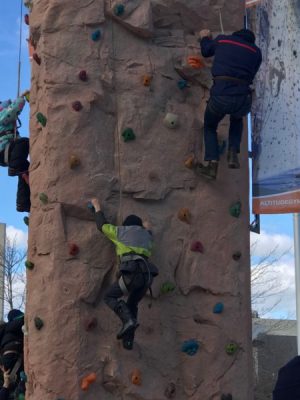By: Jessica Kalen, OTA & PTA Diploma Program Humber College Institute of Technology and Advanced Learning
All posts are reviewed by a supervising Occupational Therapist. Toronto Children’s Therapy Center is appreciative of the time and research, placement students commit to in writing posts for our blog.
 What is proprioception?
What is proprioception?
Proprioception provides us with information about the position, force, direction and movements of our body parts. The receptors that send this information to the brain are located within our muscles, tendons, and joints. The proprioceptive information is sent to the brain whenever our muscles are contracting or stretching, or when they are in a bent or straight position. Essentially, proprioceptive information tells us the relative position of our limbs without having to rely on our vision to provide us with cues. Proprioceptive feedback allows for smooth transitions and accommodations whenever movements are occurring.
A child with poor proprioceptive processing may demonstrate:
- A need to constantly crash, touch, or lean against objects or people
- Holding objects too tightly, inducing a lot of pressure
- A need to bite or chew objects
- Often times will run or stomp, in times where walking is most appropriate
What is Body Awareness?
Body awareness is our internal understanding of where our bodies are in space – essentially a mental map of our bodies. The information we get from our proprioreceptors in our joints, muscles, and tendons supports our body awareness or mental map of our bodies. When the proprioceptive information is sent to our brains, it influences our bodies to move in a fluent and coordinated pattern. To have good body awareness, there needs to be enough proprioceptive feedback being provided by the muscles and joints. Good body awareness allows us to be aware of how wide our shoulders are, for example, in order to walk through a doorway without bumping into the door frame. Body awareness also allows us to judge how close or far away our bodies are to another. Not only does body awareness help develop our fine and gross motor skills, but it also helps us to establish an efficiency in the way that we move that is more concise.
A child with poor body awareness will often times show signs of:
- Uncoordinated and clumsy movements
- Relying too highly on vision – therefore will be resistant to closing their eyes during movement
- Prefer to be in smaller areas – giving them a better sense of where their bodies are in space
- An inability to mimic an action
How do we use this to move?
Once the proprioceptive information is provided to us, we are then able to create smooth, coordinated and complex movements – ones that involve balance and control. Activities that involve large movements and larger muscles – gross motor movements – provide us with the most proprioceptive input. This is because the larger joints and muscles house more surface area and thus more proprioreceptors, providing us with information to achieve better body awareness.
Proprioceptive activities that enhance our body awareness can include, but are not limited to:
- Jumping – either on a trampoline or just up and down on a flat surface
- Weight-bearing activities such as push ups or wall pushes
- Deep pressure activities provided through squeezing or massaging of the joints and muscles
What can we do?
- Creating fun obstacle courses for a child provides proprioceptive feedback to the brain teaching us how each body part moves, enhances coordination of body parts and therefore increases overall body awareness, and enhances motor planning and motor control.
- Engaging in games such as “Simon Says” encourages body awareness
- Obstacle courses that incorporate movements that involve going up, down, and around
- Occupational Therapists are trained to provide graded activities to support the development of body awareness within a child’s abilities; for additional support please contact an occupational therapist
References:
Body Awareness. (n.d.). Retrieved from https://nspt4kids.com/healthtopics-and
conditions-database/body-awareness/
Kranowitz, C. S. (2006). The out-of-sync child has fun: Activities for kids with sensory
integration dysfunction. New York: Penguin Group.
Riemann, B. L., & Lephart, S. M. (2002). The sensorimotor system, part II: the role of
proprioception in motor control and functional joint stability. Journal of athletic
training, 37(1), 80.
Villaneda, A. (2017, August 04). BODY AWARENESS: Characteristics of Impaired or
Poor Proprioception in Your Child. Retrieved from
https://ilslearningcorner.com/blog/2016/07/07/2016-07-body-awareness
characteristics-impaired-poor-proprioception-child/
